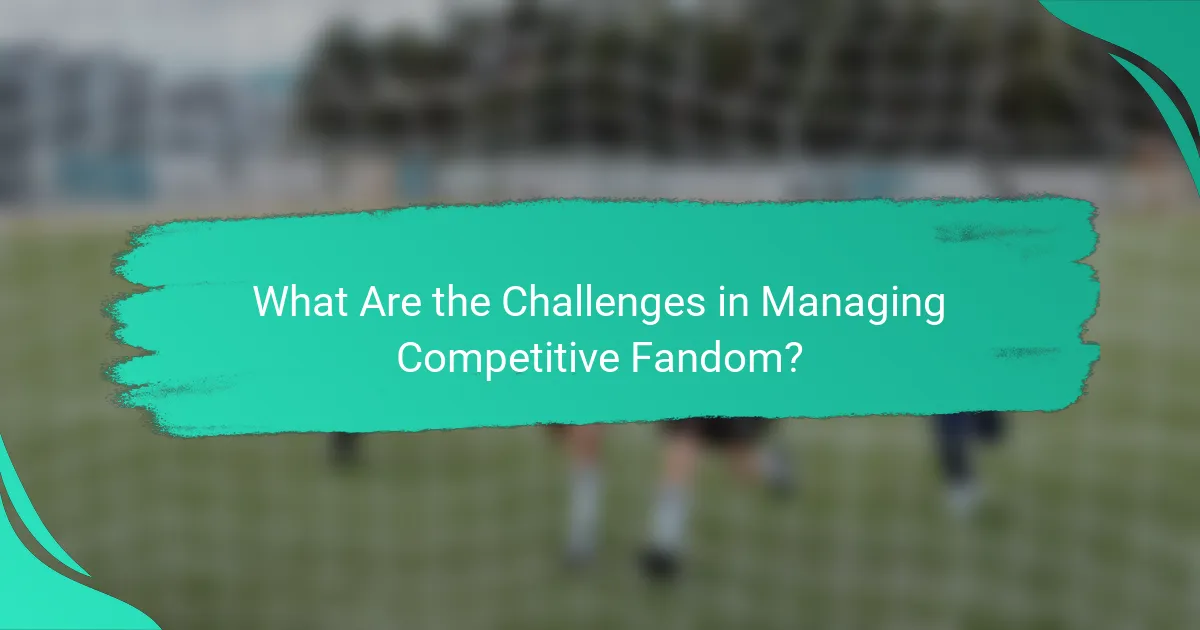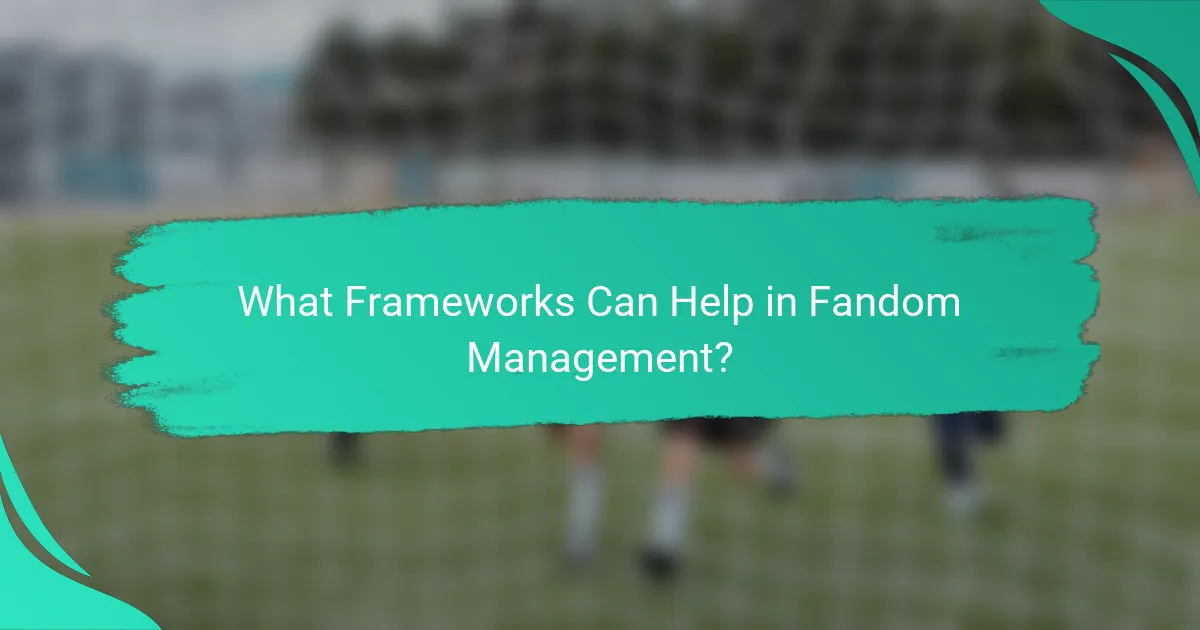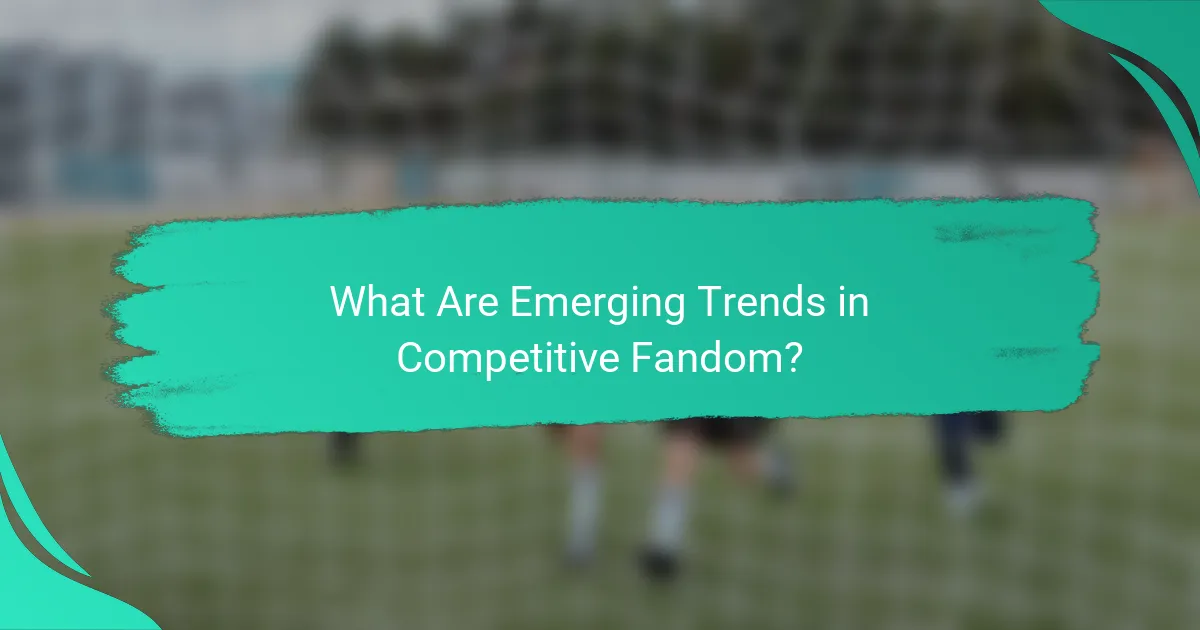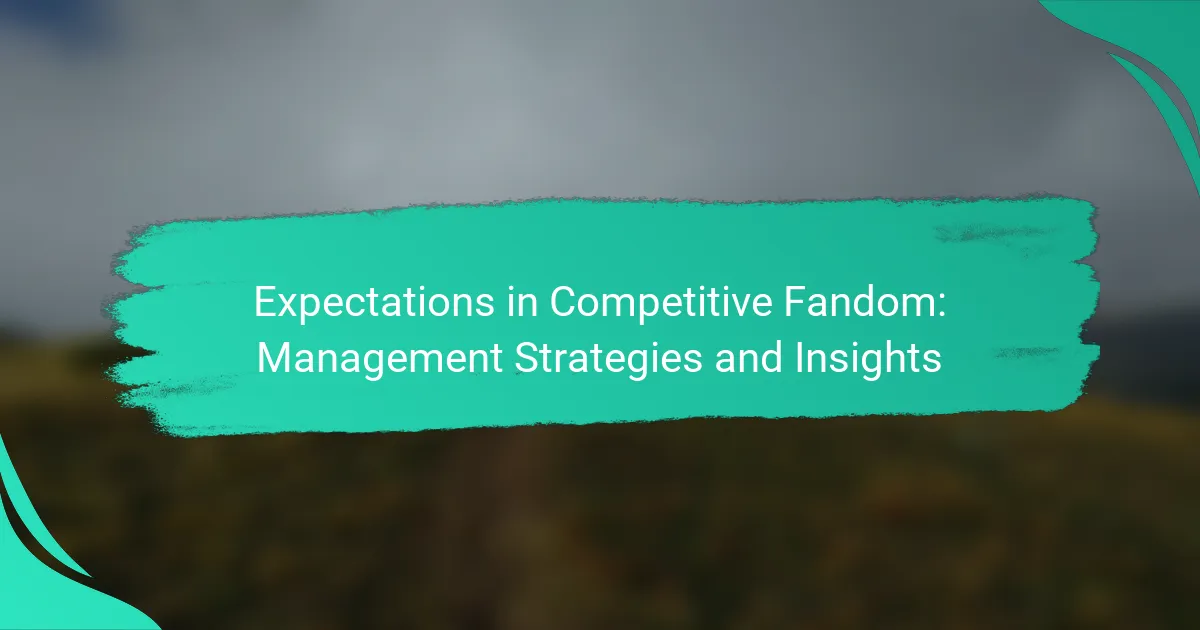In the realm of competitive fandom, effective management strategies are essential for fostering community and enhancing engagement. By understanding fan motivations and behaviors, organizations can create tailored experiences that build brand loyalty and resolve conflicts. Measuring engagement through specific metrics allows for deeper insights into fan interactions, ultimately refining strategies for a more connected and satisfied community.

What Are Effective Management Strategies for Competitive Fandom?
Effective management strategies for competitive fandom focus on fostering community, resolving conflicts, building brand loyalty, leveraging data, and optimizing content. These strategies help organizations navigate the complexities of passionate fan bases while enhancing engagement and satisfaction.
Community Engagement Techniques
Community engagement techniques are essential for creating a vibrant fan environment. Strategies such as hosting events, creating online forums, and utilizing social media platforms can significantly enhance interaction among fans. Regularly soliciting feedback and involving fans in decision-making processes can also strengthen their connection to the community.
Consider organizing fan meet-ups or virtual events that allow fans to share their experiences and ideas. This not only builds camaraderie but also encourages a sense of belonging, which is crucial in competitive fandom.
Conflict Resolution Approaches
Effective conflict resolution approaches are vital in managing competitive fandom dynamics. Establishing clear guidelines for acceptable behavior and providing channels for reporting issues can help mitigate disputes. Active listening and empathy are key in addressing concerns and finding common ground among fans.
Implementing a mediation process can also be beneficial. This allows for a structured approach to resolving conflicts, ensuring that all parties feel heard and respected, which can prevent escalation and promote a healthier community atmosphere.
Brand Loyalty Building Methods
Building brand loyalty in competitive fandom requires consistent engagement and value delivery. Offering exclusive content, rewards programs, and personalized experiences can significantly enhance fan loyalty. Regularly communicating brand values and mission can also resonate with fans, fostering a deeper emotional connection.
Consider implementing tiered membership programs that provide fans with varying levels of access and benefits. This can motivate fans to engage more deeply with the brand while feeling appreciated for their loyalty.
Data-Driven Decision Making
Data-driven decision making involves using analytics to inform strategies within competitive fandom. Collecting and analyzing fan behavior data can provide insights into preferences, engagement patterns, and potential areas for improvement. Utilizing tools like surveys and social media analytics can help in understanding fan sentiment and trends.
Establishing key performance indicators (KPIs) related to fan engagement can guide strategic adjustments. Regularly reviewing these metrics allows organizations to adapt their approaches based on real-time feedback and changing fan dynamics.
Content Strategy Optimization
Optimizing content strategy is crucial for maintaining fan interest and engagement. Creating diverse content types, such as videos, articles, and interactive posts, can cater to different fan preferences. Regularly updating content and aligning it with current trends can keep the community engaged and informed.
Consider developing a content calendar that outlines upcoming themes and events. This helps ensure a consistent flow of relevant content while allowing for flexibility to respond to fan interests and current events in the fandom landscape.

How Can Brands Leverage Competitive Fandom?
Brands can effectively leverage competitive fandom by engaging with passionate communities, creating tailored experiences, and fostering loyalty. Understanding the motivations and behaviors of fans allows brands to connect deeply and drive brand advocacy.
Utilizing Social Media Platforms
Social media platforms are vital for brands to engage with competitive fandoms. By creating dedicated channels or groups, brands can facilitate discussions, share updates, and respond to fan inquiries in real-time. This interaction builds a sense of community and belonging among fans.
Brands should consider using platforms like Twitter for quick updates and Instagram for visual storytelling. Regularly posting engaging content, such as polls or fan spotlights, can enhance interaction and keep the community active.
Creating Exclusive Content
Exclusive content is a powerful tool to attract and retain competitive fans. Brands can offer behind-the-scenes footage, early access to products, or limited-edition merchandise to create a sense of urgency and exclusivity. This approach not only rewards loyal fans but also encourages new fans to engage.
Consider developing content that resonates with the fandom’s interests, such as tutorials, interviews with key figures, or interactive experiences. This targeted content can significantly enhance fan loyalty and brand perception.
Hosting Fan Events
Hosting fan events, whether virtual or in-person, can strengthen the bond between brands and their competitive fandoms. These events can range from tournaments and meet-and-greets to exclusive product launches. They provide fans with memorable experiences that deepen their connection to the brand.
When planning events, consider the preferences of your audience. Offering merchandise, interactive sessions, or guest appearances can enhance the experience. Additionally, ensure to promote these events across social media to maximize attendance and engagement.

What Metrics Should Be Used to Measure Fandom Engagement?
To effectively measure fandom engagement, focus on metrics that reflect interaction, content sharing, and community growth. These metrics provide insight into how fans connect with content and each other, helping to refine strategies for deeper engagement.
Fan Interaction Rates
Fan interaction rates gauge how actively fans engage with content through likes, comments, shares, and participation in events. High interaction rates indicate a strong connection between the fandom and the content, while low rates may suggest a need for more engaging material or outreach.
Consider tracking interactions across various platforms, such as social media, forums, and fan events. A good benchmark is aiming for interaction rates of 5-10% of total followers or viewers, depending on the platform.
Content Shareability Metrics
Content shareability metrics assess how often fans share content with their networks, amplifying reach and visibility. Key indicators include the number of shares, retweets, and reposts across social media platforms.
To enhance shareability, create content that resonates emotionally or provides value, such as tutorials or behind-the-scenes insights. Aim for a share rate of at least 2-5% of total views to ensure your content is effectively reaching new audiences.
Community Growth Statistics
Community growth statistics track the increase in fan base size over time, reflecting the overall health of the fandom. Metrics include new followers, active members in forums, and attendance at events.
Monitor growth trends monthly or quarterly, aiming for a consistent increase of 10-20% in followers or active participants. Engaging content and regular interaction can significantly boost community growth, making it essential to maintain a steady flow of fresh material and engagement opportunities.

What Are the Challenges in Managing Competitive Fandom?
Managing competitive fandom involves navigating the complex dynamics between fan expectations and brand identity. Key challenges include balancing brand image, addressing negative feedback, and effectively allocating resources to meet fan demands.
Balancing Brand Image with Fan Expectations
Maintaining a strong brand image while meeting fan expectations can be difficult. Brands must ensure that their messaging aligns with fan desires without compromising their core values. For example, a gaming company may need to adapt its game mechanics based on fan feedback while still preserving the original vision of the game.
To achieve this balance, brands should actively engage with their fan base through surveys and social media interactions. This feedback loop can help identify areas where adjustments are necessary while reinforcing the brand’s identity.
Addressing Negative Feedback
Negative feedback is an inevitable part of managing competitive fandom. Brands must respond promptly and constructively to criticism to maintain trust and loyalty among fans. Ignoring or dismissing negative comments can lead to increased backlash and a decline in brand reputation.
Implementing a structured approach to handle negative feedback is essential. This could include establishing a dedicated team to monitor fan discussions and respond to concerns, as well as creating a transparent communication strategy that outlines how feedback will be addressed.
Managing Resource Allocation
Effective resource allocation is crucial in meeting the demands of a competitive fanbase. Brands need to prioritize projects and initiatives based on fan interest and potential impact on brand loyalty. This may involve investing in community engagement activities or enhancing product features that fans are passionate about.
To optimize resource allocation, brands can use analytics tools to track fan engagement and preferences. This data-driven approach allows brands to make informed decisions about where to allocate resources for maximum impact, ensuring that fan expectations are met without overextending the brand’s capabilities.

What Frameworks Can Help in Fandom Management?
Effective fandom management can benefit from structured frameworks that provide clarity and direction. Utilizing tools like SWOT analysis and fan persona development helps organizations understand their community’s strengths, weaknesses, opportunities, and threats, while also tailoring engagement strategies to specific fan segments.
SWOT Analysis for Fan Communities
SWOT analysis is a strategic planning tool that identifies the strengths, weaknesses, opportunities, and threats related to fan communities. By assessing these four areas, organizations can better understand their position within the fandom landscape and make informed decisions on how to engage their audience.
For instance, a fan community may have strong social media presence (strength), but face challenges in maintaining active participation (weakness). Opportunities might include collaborations with influencers, while threats could stem from competing fandoms or negative publicity. Regularly updating this analysis can help in adapting strategies effectively.
Fan Persona Development
Fan persona development involves creating detailed profiles of different segments within a fan community. This process helps organizations tailor their content and engagement strategies to meet the specific needs and preferences of various fan types.
To create effective fan personas, consider demographics, interests, motivations, and behaviors. For example, a persona might represent younger fans who prefer digital interactions and social media engagement, while another could focus on older fans who value in-person events and merchandise. Regularly revisiting these personas ensures they remain relevant and useful.

What Are Emerging Trends in Competitive Fandom?
Emerging trends in competitive fandom include the rise of digital platforms, increased community engagement, and the growing influence of social media. These trends shape how fans interact with their favorite teams or players, creating new opportunities for management strategies.
Digital Engagement Strategies
Digital engagement strategies focus on utilizing online platforms to connect with fans. This includes leveraging social media, streaming services, and dedicated fan forums to foster interaction. For example, teams may host live Q&A sessions or behind-the-scenes content to enhance fan loyalty.
Effective digital strategies often involve regular updates and interactive content, such as polls or contests. These initiatives can significantly boost fan participation and create a sense of community, which is essential in competitive fandom.
Community Building Initiatives
Community building initiatives are crucial for fostering a loyal fan base. These initiatives can include organizing local events, fan meet-ups, or charity drives that align with the team’s values. By engaging fans in meaningful ways, organizations can strengthen their connection to the community.
Additionally, creating exclusive fan clubs or membership programs can enhance the sense of belonging. Offering perks like early ticket access or exclusive merchandise can incentivize fans to participate more actively.
Influence of Social Media
Social media plays a pivotal role in shaping competitive fandom. Platforms like Twitter, Instagram, and TikTok allow fans to share their experiences and opinions instantly. This real-time interaction can amplify fan engagement and influence public perception of teams and players.
However, organizations must navigate the challenges of managing online discourse. Monitoring social media sentiment and responding appropriately can help mitigate negative feedback and enhance brand loyalty.
